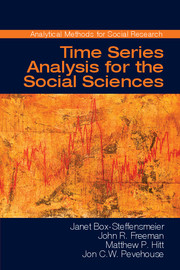Book contents
- Frontmatter
- Dedication
- Contents
- Preface
- 1 Modeling Social Dynamics
- 2 Univariate Time Series Models
- 3 Dynamic Regression Models
- 4 Modeling the Dynamics of Social Systems
- 5 Univariate, Nonstationary Processes: Tests and Modeling
- 6 Cointegration and Error Correction Models
- 7 Selections on Time Series Analysis
- 8 Concluding Thoughts for the Time Series Analyst
- Appendix Time Series Models as Difference Equations
- Bibliography
- Index
Preface
Published online by Cambridge University Press: 05 December 2014
- Frontmatter
- Dedication
- Contents
- Preface
- 1 Modeling Social Dynamics
- 2 Univariate Time Series Models
- 3 Dynamic Regression Models
- 4 Modeling the Dynamics of Social Systems
- 5 Univariate, Nonstationary Processes: Tests and Modeling
- 6 Cointegration and Error Correction Models
- 7 Selections on Time Series Analysis
- 8 Concluding Thoughts for the Time Series Analyst
- Appendix Time Series Models as Difference Equations
- Bibliography
- Index
Summary
Our work has several motivations. We think that longitudinal analysis provides infinitely more insight than does examining any one slice of time. As we show throughout the book, longitudinal analysis is essential for the study of normatively important problems such as democratic accountability and international conflict. Given the importance of dynamic analysis in answering new questions and providing new answers to old questions, we want to get more social scientists thinking in dynamic terms. Time series is one of the most useful tools for dynamic analysis, and our goal is to provide a more accessible treatment for this approach. We are also motivated by the burgeoning supply of new social science time series data. Sometimes this causes the opposite problem of too much data and figuring out how to analyze it, but that is a problem we gladly embrace. The proliferation of new social science data requires techniques that are designed to handle complexity, and time series analysis is one of the most applicable tools. The incorporation of time series analysis into standard statistical packages such as STATA and R, as well as the existence of specialized packages such as RATS and Eviews, provides an additional motivation because it enables more scholars to easily use time series in their work.
We have found over our years of teaching time series that, although many social science students have the brain power to learn time series methods, they often lack the training and motivation to use the most well-known books on the topic.
- Type
- Chapter
- Information
- Time Series Analysis for the Social Sciences , pp. xiii - xviPublisher: Cambridge University PressPrint publication year: 2014

